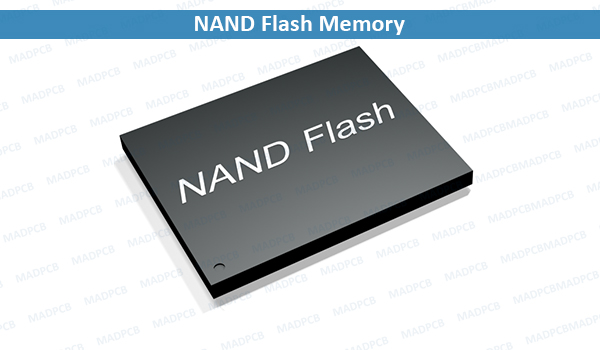What Is NAND Flash?
NAND Flash uses floating-gate transistors, but they are connected in a way that resembles a NAND gate: several transistors are connected in series, and the bit line is pulled low only if all the word lines are pulled high (above the transistors’ VT). These groups are then connected via some additional transistors to a NOR-style bit line array in the same way that single transistors are linked in NOR flash.
Compared to NOR flash, replacing single transistors with serial-linked groups adds an extra level of addressing. Whereas NOR flash might address memory by page then word, NAND flash might address it by page, word and bit. Bit-level addressing suits bit-serial applications (such as hard disk emulation), which access only one bit at a time. Execute-in-place applications, on the other hand, require every bit in a word to be accessed simultaneously. This requires word-level addressing. In any case, both bit and word addressing modes are possible with either NOR or NAND flash.
To read data, first the desired group is selected (in the same way that a single transistor is selected from a NOR array). Next, most of the word lines are pulled up above the VT of a programmed bit, while one of them is pulled up to just over the VT of an erased bit. The series group will conduct (and pull the bit line low) if the selected bit has not been programmed.
Despite the additional transistors, the reduction in ground wires and bit lines allows a denser layout and greater storage capacity per chip. (The ground wires and bit lines are actually much wider than the lines in the diagrams.) In addition, NAND flash is typically permitted to contain a certain number of faults (NOR flash, as is used for a BIOS ROM, is expected to be fault-free). Manufacturers try to maximize the amount of usable storage by shrinking the size of the transistors.
NAND Flash cells are read by analyzing their response to various voltages.
Writing and Erasing
NAND flash uses tunnel injection for writing and tunnel release for erasing. NAND flash memory forms the core of the removable USB storage devices known as USB flash drives, as well as most memory card formats and solid-state drives (SSD) available today.
The hierarchical structure of NAND Flash starts at a cell level which establishes strings, then pages, blocks, planes and ultimately a die. A string is a series of connected NAND cells in which the source of one cell is connected to the drain of the next one. Depending on the NAND technology, a string typically consists of 32 to 128 NAND cells. Strings are organised into pages which are then organised into blocks in which each string is connected to a separate line called a bitline (BL) All cells with the same position in the string are connected through the control gates by a wordline (WL) A plane contains a certain number of blocks that are connected through the same BL. A Flash die consists of one or more planes, and the peripheral circuitry that is needed to perform all the read/ write/ erase operations.
The architecture of NAND Flash means that data can be read and programmed in pages, typically between 4 KiB and 16 KiB in size, but can only be erased at the level of entire blocks consisting of multiple pages and MB in size. When a block is erased all the cells are logically set to 1. Data can only be programmed in one pass to a page in a block that was erased. Any cells that have been set to 0 by programming can only be reset to 1 by erasing the entire block. This means that before new data can be programmed into a page that already contains data, the current contents of the page plus the new data must be copied to a new, erased page. If a suitable page is available, the data can be written to it immediately. If no erased page is available, a block must be erased before copying the data to a page in that block. The old page is then marked as invalid and is available for erasing and reuse.
MADPCB provides printed circuit board (PCB) manufacturing, assembly and design services, and components sourcing and IC programming value-added services.
NAND Flash vs. NOR Flash Memory
Flash memory is an electronic non-volatile computer memory storage medium that can be electrically erased and reprogrammed. The two main types of flash memory, NOR flash and NAND flash, are named for the NOR and NAND logic gates. NAND flash and NOR flash use the same cell design, consisting of floating gate MOSFETs. They differ at the circuit level: in NAND flash, the relationship between the bit line and the word lines resembles a NAND gate; in NOR flash, it resembles a NOR gate; this depends on whether the state of the bit line or word lines is pulled high or low.

